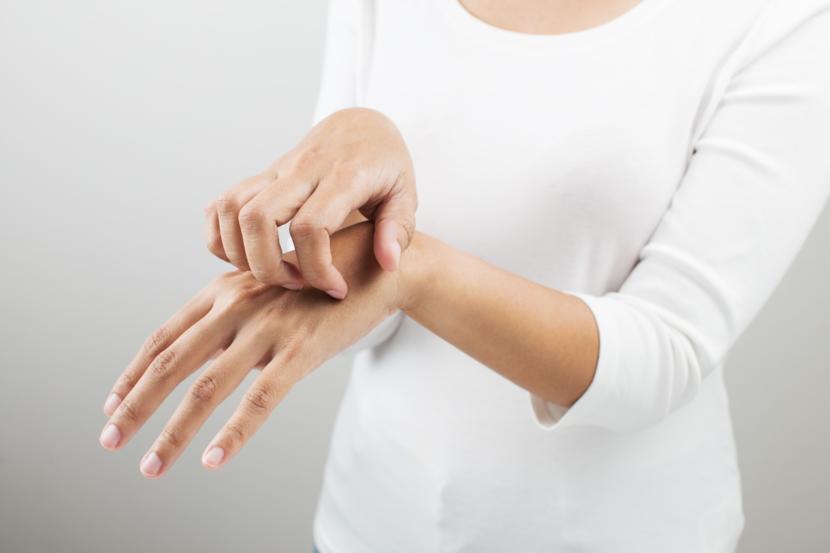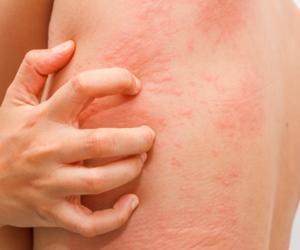Is Candidiasis of the Skin Contagious?

What is candidiasis of the skin?
There are various types of bacteria and fungi that thrive on the skin. Strangely, these bacteria and fungi are a part of the natural environment and many of them help the body carry out normal functions. However, some of these bacteria and fungi can negatively react with the body and when these organisms uncontrollably grow and multiply, they can cause serious infections of the skin that need immediate medical attention. If not properly treated, these infections have a chance to spread.
One potentially harmful organism is a fungus called Candida. An overgrowth of Candida on the skin can lead to a severe infection. This condition is referred to as candidiasis of the skin or cutaneous candidiasis.
Candidiasis of the skin is characterized by the appearance of red and itchy rashes that commonly affect moist regions and skin folds. If left untreated, this rash can rapidly spread to other areas of the body. While the symptoms often look worrisome, they can be treated with timely medication and improved hygiene.
What causes candidiasis of the skin?
Candidiasis of the skin is a skin infection that develops when the skin is infected with Candida. This fungus naturally thrives on the skin. However, when this fungus uncontrollably grows and multiplies to form colonies, it results in a fungal skin infection. There are a number of reasons associated with the growth of Candida on the skin, and they include:
- Warm and humid climate
- Tight clothing
- Poor hygiene
- Not changing clothes, particularly undergarments
- Antibiotics that kill harmless bacteria on your skin
- Medical conditions such as diabetes, weakened immune system, or pregnancy
- Leaving the skin damp and wet without drying properly
Candida thrives and grows in warm and moist areas, which is why the skin folds provide the best environment for its growth. Babies are also susceptible to developing candidiasis of the skin. The diaper provides a favorable environment for fungi to grow leading to infants developing rashes on their buttocks.
Is candidiasis of the skin contagious?
Candidiasis of the skin is not usually contagious, but it is possible for the fungus to infect other people who have weak immune systems. Those with underlying health conditions that weaken their immunity are more likely to develop fungal infections compared to healthy individuals.
Symptoms of Candidiasis of the Skin
The most prominent symptom of candidiasis of the skin is a rash, which eventually causes redness and severe itching. In some instances, the infection tends to worsen causing the skin to crack and become sore. Blisters and pustules may also occur.
The rash can appear on various parts of the body and is most likely to develop in the folds of the skin. These areas include the armpits, the groin region, between the fingers, and under the breasts. Candida can also lead to infections in the nails, edges of the nails, and corners of the mouth.
Diagnosis
Doctors usually perform a simple physical examination after taking your medical history. The skin infected by the rash is examined by the doctor to determine the nature of the infection.
The doctor may also recommend a culture before confirming the diagnosis. For a skin culture, a cotton swab is used to collect a skin sample. The sample is thereafter sent to the laboratory to confirm the growth of Candida.
Ways to Treat Candidiasis of the Skin
1. Hygiene
Candidiasis of the skin can be treated using home remedies and by following healthy hygiene habits. Wash your skin regularly using an antibacterial soap and dry your skin thoroughly, especially in the skin folds to prevent the growth of fungi.
2. Mycolog II Topical
In more severe cases of candidiasis, doctors may recommend using an antifungal cream or powder that can be applied to the infected region of the skin. This medication helps in killing the fungus and reducing the spread of the infection.
If the infection has already spread to areas inside the body, such the throat or mouth region, oral antifungal medications may be required to treat the infection. Topical medications like Mycolog II is prescribed in most cases to treat the fungal infection. This medicine contains nystatin, which is an antifungal drug that acts on the infected area and stops the growth of the fungus. It also contains triamcinolone, an anti-inflammatory corticosteroid that reduces symptoms such as swelling, itching, and redness. This medication is only prescribed by healthcare providers for the treatment of fungal skin infections.
3. Blood Sugar Levels
Fluctuating and high blood sugar levels can lead to the development of Candida infections. Keeping blood sugar levels under control may also help relieve the symptoms.
Blood sugar levels can be kept under control by incorporating healthy lifestyle habits such as eating healthy and exercising as parts of your everyday routine. For those who have high blood sugar levels, medications or insulin must be taken according to your doctor's recommendations.
Effective Home Remedies
While there are medications for the treatment of Candida growth, there are a number of effective home remedies that can have a similar efficacy in getting rid of the infection. Some of these remedies are:
- Apple Cider Vinegar: Apple cider vinegar has natural antiseptic properties that can help get rid of fungal infections. Dip a cotton ball in apple cider vinegar and apply it to the infected area. Although the symptoms may ease over a period of time, healing takes place naturally without any side effects.
- Tea Tree Oil: Tea tree oil is a well-known essential oil with antiseptic properties that help fight infections. Dabbing some tea tree oil to the affected area can greatly help in soothing irritation and symptoms of the fungal infection.
- Garlic: Garlic contains sulfur-rich compounds with natural anti-fungal properties, which help in treating infections caused by Candida.
- Yogurt: Probiotics in yogurt are helpful in fighting candidiasis or yeast infections. The Lactobacillus acidophilus culture, in particular, keeps Candida in check by producing lactic acid.
- Oregano Oil: Oregano oil is rich in a fungus-fighting compound called carvacrol. Research states that the oil’s antifungal and antimicrobial agents can be effectively used for the treatment and prevention of candidiasis. Mixing three drops of oregano oil with one tablespoon of olive oil and applying it to the affected area for a few hours can work wonders in treating the infection. Oregano oil is also available in the form of capsules that can be consumed until the symptoms of the infection settle down.















